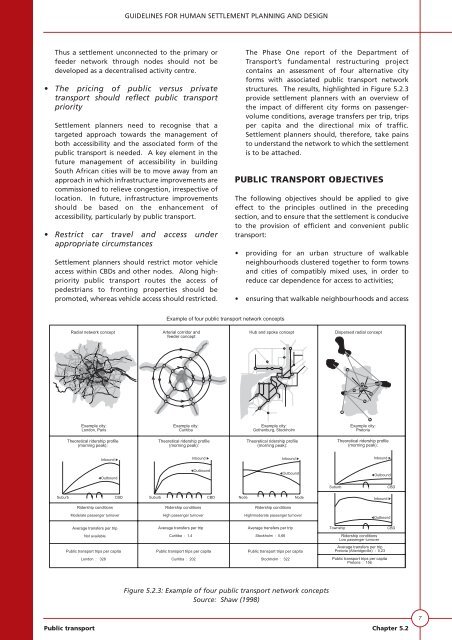VOLUME 1 HUMAN SETTLEMENT PLANNING AND ... - CSIR
VOLUME 1 HUMAN SETTLEMENT PLANNING AND ... - CSIR
VOLUME 1 HUMAN SETTLEMENT PLANNING AND ... - CSIR
- No tags were found...
Create successful ePaper yourself
Turn your PDF publications into a flip-book with our unique Google optimized e-Paper software.
GUIDELINES FOR <strong>HUMAN</strong> <strong>SETTLEMENT</strong> <strong>PLANNING</strong> <strong>AND</strong> DESIGNThus a settlement unconnected to the primary orfeeder network through nodes should not bedeveloped as a decentralised activity centre.• The pricing of public versus privatetransport should reflect public transportprioritySettlement planners need to recognise that atargeted approach towards the management ofboth accessibility and the associated form of thepublic transport is needed. A key element in thefuture management of accessibility in buildingSouth African cities will be to move away from anapproach in which infrastructure improvements arecommissioned to relieve congestion, irrespective oflocation. In future, infrastructure improvementsshould be based on the enhancement ofaccessibility, particularly by public transport.• Restrict car travel and access underappropriate circumstancesSettlement planners should restrict motor vehicleaccess within CBDs and other nodes. Along highprioritypublic transport routes the access ofpedestrians to fronting properties should bepromoted, whereas vehicle access should restricted.The Phase One report of the Department ofTransport’s fundamental restructuring projectcontains an assessment of four alternative cityforms with associated public transport networkstructures. The results, highlighted in Figure 5.2.3provide settlement planners with an overview ofthe impact of different city forms on passengervolumeconditions, average transfers per trip, tripsper capita and the directional mix of traffic.Settlement planners should, therefore, take painsto understand the network to which the settlementis to be attached.PUBLIC TRANSPORT OBJECTIVESThe following objectives should be applied to giveeffect to the principles outlined in the precedingsection, and to ensure that the settlement is conduciveto the provision of efficient and convenient publictransport:• providing for an urban structure of walkableneighbourhoods clustered together to form townsand cities of compatibly mixed uses, in order toreduce car dependence for access to activities;• ensuring that walkable neighbourhoods and accessExample of four public transport network conceptsRadial network conceptArterial corridor andfeeder conceptHub and spoke conceptDispersed radial conceptExample city:London, ParisExample city:CuritibaExample city:Gothenburg, StockholmExample city:PretoriaTheoretical ridership profile(morning peak):Theoretical ridership profile(morning peak):Theoretical ridership profile(morning peak):Theoretical ridership profile(morning peak):InboundInboundInboundInboundOutboundOutboundOutboundOutboundSuburbCBDSuburbCBDSuburbCBDNodeNodeInboundRidership conditionsRidership conditionsRidership conditionsModerate passenger turnoverHigh passenger turnoverHigh/moderate passenger turnoverOutboundAverage transfers per tripAverage transfers per tripAverage transfers per tripTownshipCBDNot availableCuritiba : 1,4Stockholm : 0,66Ridership conditionsLow passenger turnoverPublic transport trips per capitaPublic transport trips per capitaPublic transport trips per capitaAverage transfers per tripPretoria (Atteridgeville) : 0,23London : 328Curitiba : 202Stockholm : 322Public transport trips per capitaPretoria : 156Figure 5.2.3: Example of four public transport network conceptsSource: Shaw (1998)Public transport Chapter 5.27
















